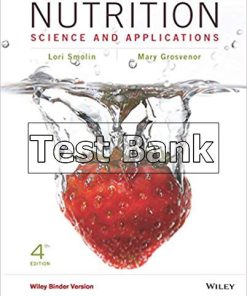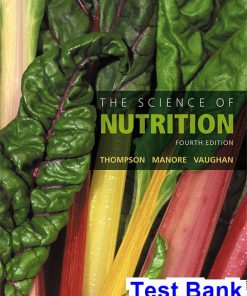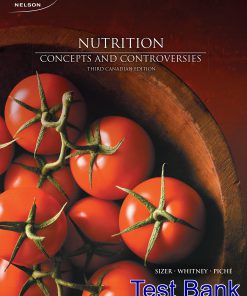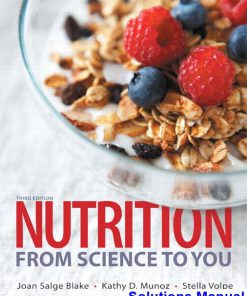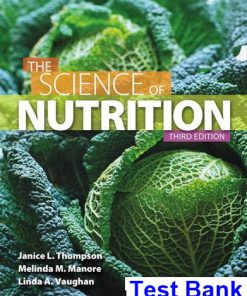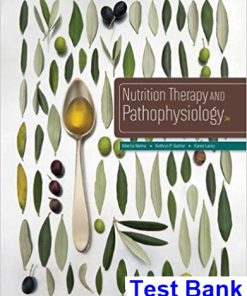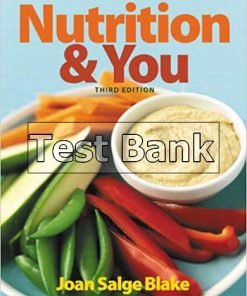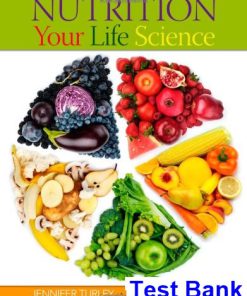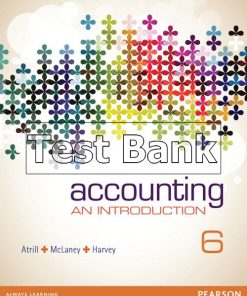Nutrition Science and Applications 3rd Edition Smolin Test Bank
$50.00 Original price was: $50.00.$26.50Current price is: $26.50.
Nutrition Science and Applications 3rd Edition Smolin Test Bank.
This is completed downloadable of Nutrition Science and Applications 3rd Edition Smolin Test Bank
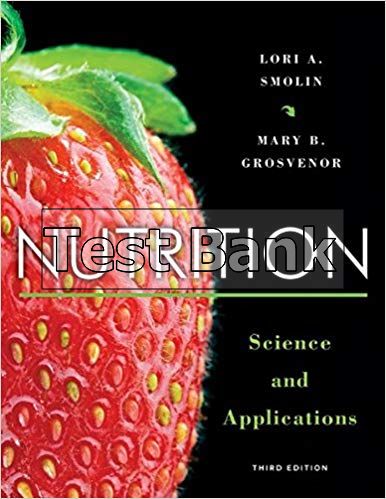
Product Details:
- ISBN-10 : 1118342925
- ISBN-13 : 978-1118342923
- Author; Lori A. Smolin (Author), Mary B. Grosvenor (Author)
Nutrition: Science and Applications, Binder Ready Version 3 Edition helps develop the scientific understanding to support personal and professional decisions. Using a critical thinking approach, Smolin brings nutrition out of the classroom and allows students to apply the logic of science to their own nutrition concerns both as consumers and as future scientists and health professionals. The text and WileyPLUS course has been developed through collaboration between the authors and the Nutrition Advisory Board, a team of dedicated nutrition instructors who help review and develop all of Wiley’s nutrition resources.
Table of Content:
- CHAPTER 1: Nutrition: Food for Health
- Case Study
- 1.1 Nutrition and the Canadian Diet
- 1.2 Food Provides Nutrients
- 1.3 Food Choices for a Healthy Diet
- 1.4 Understanding Science Helps Us Understand Nutrition
- 1.5 Nutrition Research
- 1.6 Sorting Out Nutrition Information
- Case Study Outcome
- Applications
- Summary
- References
- CHAPTER 2: Nutrition Guidelines: Applying the Science of Nutrition
- Case Study
- 2.1 Nutrition Recommendations for the Canadian Diet
- 2.2 Dietary Reference Intakes
- 2.3 Canada’s Food Guide 2019
- 2.4 Other Food Guides and Dietary Patterns
- 2.5 Food and Natural Health Product Labels
- 2.6 Assessing Nutritional Health
- Case Study Outcome
- Applications
- Summary
- References
- CHAPTER 3: Digestion, Absorption, and Metabolism
- Case Study
- 3.1 Food Becomes Us
- 3.2 An Overview of the Digestive System
- 3.3 Digestion and Absorption
- 3.4 Digestion and Health
- 3.5 Transporting Nutrients to Body Cells
- 3.6 Metabolism of Nutrients: An Overview
- 3.7 Elimination of Metabolic Wastes
- Case Study Outcome
- Applications
- Summary
- References
- CHAPTER 4: Carbohydrates: Sugars, Starches, and Fibre
- Case Study
- 4.1 Carbohydrates in the Canadian Diet
- 4.2 The Chemistry of Carbohydrates
- 4.3 Carbohydrates in the Digestive Tract
- 4.4 Carbohydrates in the Body
- 4.5 Blood-Glucose Regulation, Diabetes and Hypoglycemia
- 4.6 Carbohydrates and Health
- 4.7 Meeting Carbohydrate Recommendations
- Case Study Outcome
- Applications
- Summary
- References
- FOCUS ON 1: Beyond the Basics: Meal Planning for Healthy Eating, Diabetes Prevention and Management
- Case Study: Samantha and Robert
- F1.1 Using Beyond the Basics
- Case Study Outcome
- CHAPTER 5: Lipids
- Case Study
- 5.1 Fat in the Canadian Diet
- 5.2 Types of Lipid Molecules
- 5.3 Lipids in the Digestive Tract
- 5.4 Lipid Transport in the Body
- 5.5 Lipid Functions in the Body
- 5.6 Lipids and Health
- 5.7 Meeting Recommendations for Fat Intake
- Case Study Outcome
- Applications
- Summary
- References
- FOCUS ON 2: Alcohol
- Introduction
- F2.1 What’s in Alcoholic Beverages?
- F2.2 Absorption, Transport, and Excretion of Alcohol
- F2.3 Alcohol Metabolism
- F2.4 Adverse Effects of Alcohol Consumption
- F2.5 Benefits of Alcohol Consumption
- F2.6 Balancing the Risks and Benefits of Alcohol
- References
- CHAPTER 6: Proteins and Amino Acids
- Case Study
- 6.1 Protein in the Canadian Diet
- 6.2 Protein Molecules
- 6.3 Protein in the Digestive Tract
- 6.4 Protein in the Body
- 6.5 Protein, Amino Acids, and Health
- 6.6 Meeting Protein Needs
- 6.7 Meeting Needs with a Vegetarian Diet
- Case Study Outcome
- Applications
- Summary
- References
- CHAPTER 7: Energy Balance and Weight Management
- Case Study
- 7.1 The Obesity Epidemic
- 7.2 Exploring Energy Balance
- 7.3 Estimating Energy Needs
- 7.4 Body Weight and Health
- 7.5 Guidelines for a Healthy Body Weight
- 7.6 Regulation of Energy Balance
- 7.7 Why Are Canadians Getting Heavier?: Genes versus Lifestyle
- 7.8 Achieving and Maintaining a Healthy Body Weight
- 7.9 Diets, Diets, Everywhere
- 7.10 Weight-loss Drugs and Surgery
- Case Study Outcome
- Applications
- Summary
- References
- FOCUS ON 3: Obesity, Metabolism, and Disease Risk
- Introduction
- F3.1 Obesity and Type 2 Diabetes
- F3.2 Obesity and Cardiovascular Disease
- F3.3 Obesity and Cancer
- F3.4 Obesity and Other Diseases
- References
- CHAPTER 8: The Water‐Soluble Vitamins
- 8.1 What Are Vitamins?
- 8.2 Thiamin
- 8.3 Riboflavin
- 8.4 Niacin
- 8.5 Biotin
- 8.6 Pantothenic Acid
- 8.7 Vitamin B6
- 8.8 Folate or Folic Acid
- 8.9 Vitamin B12
- 8.10 Vitamin C
- 8.11 Choline
- Case Study Outcome
- Applications
- Summary
- References
- CHAPTER 9: The Fat‐Soluble Vitamins
- Case Study
- 9.1 Fat‐Soluble Vitamins in the Canadian Diet
- 9.2 Vitamin A
- 9.3 Vitamin D
- 9.4 Vitamin E
- 9.5 Vitamin K
- Case Study Outcome
- Applications
- Summary
- References
- FOCUS ON 4: Phytochemicals
- Introduction
- F4.1 Phytochemicals in the Canadian Diet
- F4.2 Choosing a Phytochemical‐rich Diet
- References
- CHAPTER 10: Water and the Electrolytes
- Case Study
- 10.1 Water: The Internal Sea
- 10.2 Electrolytes: Salts of the Internal Sea
- 10.3 Hypertension
- Case Study Outcome
- Applications
- Summary
- References
- CHAPTER 11: Major Minerals and Bone Health
- Case Study
- 11.1 What Are Minerals?
- 11.2 Calcium
- 11.3 Calcium and Bone Health
- 11.4 Phosphorus
- 11.5 Magnesium
- 11.6 Sulfur
- Case Study Outcome
- Applications
- Summary
- References
- FOCUS ON 5: Natural Health Products
- Introduction
- F5.1 What Is a Natural Health Product?
- F5.2 Macronutrient Supplements
- F5.3 Substances Made in the Body
- F5.4 Phytochemical Supplements
- F5.5 Herbal Supplements
- References
- CHAPTER 12: The Trace Elements
- Case Study
- 12.1 Trace Elements in the Canadian Diet
- 12.2 Iron (Fe)
- 12.3 Zinc (Zn)
- 12.4 Copper (Cu)
- 12.5 Manganese (Mn)
- 12.6 Selenium (Se)
- 12.7 Iodine (I)
- 12.8 Chromium (Cr)
- 12.9 Fluoride (F)
- 12.10 Molybdenum (Mo)
- 12.11 Other Trace Elements
- Case Study Outcome
- Applications
- Summary
- References
- FOCUS ON 6: Integrating Nutrient Function in the Body
- Introduction
- F6.1 Nutrient Function at the Cellular Level
- F6.2 Nutrient Function in Organ Systems
- References
- CHAPTER 13: Nutrition and Physical Activity
- Case Study
- 13.1 Exercise, Fitness, and Health
- 13.2 Exercise Recommendations
- 13.3 Fuelling Exercise
- 13.4 Energy and Nutrient Needs for Physical Activity
- 13.5 Fluid Needs for Physical Activity
- 13.6 Food and Drink to Maximize Performance
- 13.7 Ergogenic Aids: Do Supplements Enhance Athletic Performance?
- Case Study Outcome
- Applications
- Summary
- References
- CHAPTER 14: Nutrition During Pregnancy and Lactation
- Case Study
- 14.1 The Physiology of Pregnancy
- 14.2 The Nutritional Needs of Pregnancy
- 14.3 Factors That Increase the Risks of Pregnancy
- 14.4 Lactation
- 14.5 The Nutritional Needs of Infancy
- 14.6 Feeding the Newborn
- Case Study Outcome
- Applications
- Summary
- References
- CHAPTER 15: Nutrition from Infancy to Adolescence
- Case Study
- 15.1 Starting Right for a Healthy Life
- 15.2 Nourishing Infants, Toddlers, and Young Children
- 15.3 Nutrition and Health Concerns in Children
- 15.4 Adolescents
- 15.5 Special Concerns of Teenagers
- Case Study Outcome
- Applications
- Summary
- References
- FOCUS ON 7: Eating Disorders
- Introduction
- F7.1 What Are Eating Disorders?
- F7.2 What Causes Eating Disorders?
- F7.3 Anorexia Nervosa
- F7.4 Bulimia Nervosa
- F7.5 Binge-eating Disorder
- F7.6 Eating Disorders in Special Groups
- F7.7 Preventing and Getting Treatment for Eating Disorders
- References
- CHAPTER 16: Nutrition and Aging: The Adult Years
- Case Study
- 16.1 What Is Aging?
- 16.2 What Causes Aging?
- 16.3 Nutritional Needs and Concerns of Older Adults
- 16.4 Factors That Increase the Risk of Malnutrition
- 16.5 Keeping Older Adults Healthy
- Case Study Outcome
- Applications
- Summary
- References
- CHAPTER 17: Food Safety
- Case Study
- 17.1 How Can Food Make Us Sick?
- 17.2 Keeping Food Safe
- 17.3 Pathogens in Food
- 17.4 Chemical Contaminants in Food
- 17.5 Food Technology
- Case Study Outcome
- Applications
- Summary
- References
- FOCUS ON 8: Biotechnology
- Introduction
- F8.1 How Does Biotechnology Work?
- F8.2 Applications of Modern Biotechnology
- F8.3 Safety and Regulation of Genetically Modified Foods
- References
- CHAPTER 18: World Hunger and Malnutrition
- Case Study
- 18.1 The Two Faces of Malnutrition
- 18.2 The Cycle of Malnutrition
- 18.3 Causes of Undernutrition
- 18.4 Eliminating Malnutrition
- 18.5 Hunger at Home
- Case Study Outcome
- Applications
- Summary
- References
- Appendices
- Additional DRI Tables
- Standards for Body Size
- Normal Blood Values of Nutritional Relevance
- History of Canada’s Food Guide
- Calculations and Conversions
- World Health Organization Nutrition Recommendations
- U.S. Nutrition Recommendations
- Energy Expenditure for Various Activities
- Chemistry, Metabolism, and Structures
- Glossary
- Index
- End User License Agreement
People Also Search:
nutrition science and applications smolin
nutrition science and applications 3rd edition smolin
nutrition science and applications
nutrition science and applications 3rd edition testbank download pdf
nutrition science and applications 3rd edition download scribd
nutrition science and applications 3rd edition
Instant download after Payment is complete
You may also like…
Solutions Manual
Nutrition Science and Applications 4th Edition Smolin Test Bank
Related products
Test Bank




